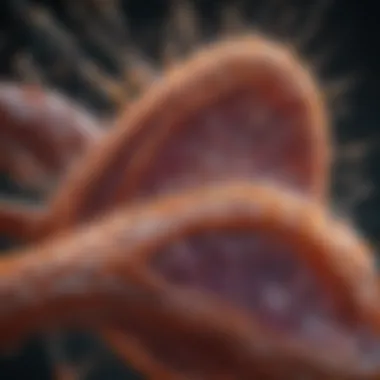Exploring FCCP Uncouplers: Mechanisms and Applications


Intro
The topic of FCCP uncouplers has garnered significant attention in the realm of biochemical research, predominantly due to their capacity to disrupt the normal flow of energy within cells. As a protonophore, FCCP (Carbonyl cyanide-4-(trifluoromethoxy)phenylhydrazone) intervenes in electron transport processes, ultimately affecting ATP synthesis. This article aims to traverse the intricate mechanisms of FCCP uncouplers, presenting a granular view of their effectiveness, implications in cellular respiration, and their burgeoning applications in both research and therapeutic domains.
Understanding how FCCP operates not only unravels its role in energetic metabolism but also illuminates its potential in experimental methodologies. Through meticulous analysis, we aim to elucidate how these uncouplers might influence various metabolic pathways, hinting at their significance in practical usage. Whether viewed through the lens of academic inquiry or therapeutic potential, the exploration of FCCP uncouplers stands poised as a crucial focus area in contemporary biological sciences.
Research Overview
Summary of Key Findings
Recent investigations into FCCP uncouplers have revealed several profound insights into their mechanisms and applications. Notably, they serve as powerful tools for researchers studying mitochondrial function and thermogenesis by effectively dissipating the proton gradient across the mitochondrial membrane. This property enables a more nuanced observation of energy expenditure within biological systems.
Key findings include:
- Disruption of ATP Production: FCCP effectively uncouples oxidative phosphorylation, facilitating a distinctive approach to gauge energy dynamics.
- Influence on Reactive Oxygen Species (ROS): Its application has been linked with increased levels of ROS, which in turn could influence signaling pathways.
- Therapeutic Implications: Initial studies suggest that FCCP might rescue mitochondrial dysfunction related to diverse pathological conditions.
Background and Context
To appreciate the role of FCCP uncouplers, one must recognize their historical context within bioenergetics research. The early exploration of mitochondrial uncouplers centered on identifying compounds that could induce heat generation (thermogenesis) rather than ATP formation within cells. The labeling of FCCP as an uncoupler represents a pivotal moment, as it laid the groundwork for subsequent research into mitochondrial function and its various disturbances.
As the scientific community increasingly focuses on metabolic diseases and aging, understanding how compounds like FCCP influence metabolic states becomes more vital. With countless studies investigating its mechanisms, it is becoming clear that FCCP's applications stretch far beyond mere scholarship, hinting at real-world impacts in therapeutic settings as well.
Methodology
Experimental Design
The experimental investigation into FCCP uncouplers typically follows a structured approach, beginning with a control group of cells subjected to standard conditions, while the test group receives varying concentrations of FCCP. These designs aim to assess both biochemical and physiological responses in a controlled environment, shedding light on specific cellular mechanisms impacted by FCCP exposure.
Data Collection Techniques
Data collection methods utilized in studies involving FCCP include:
- Oxygen Consumption Rate (OCR): A critical measure reflecting cellular respiration, allowing researchers to identify how FCCP alters energy production.
- ATP Quantification: Techniques such as luminescence assays can elucidate changes in ATP levels after treatment with FCCP.
- ROS Measurement: Utilizing fluorescent dyes to quantify ROS offers insights into how FCCP influences oxidative stress within cells.
Overall, the meticulous nature of these methodologies provides a baseline for understanding FCCP's real impacts on cellular function and contributes to the broader narrative surrounding energy metabolism and its implications.
Intro to FCCP Uncouplers
The discussion surrounding FCCP uncouplers is pivotal for anyone delving into the intricacies of cellular respiration and energy metabolism. These compounds stand at the crossroads of biochemistry, physiology, and therapeutic research, making them a topic of great importance not just for scientists but for educators and advanced students. Understanding FCCP uncouplers opens the door to insights about how energy is generated within cells, and how manipulating that process can influence various physiological responses.
Defining FCCP
FCCP, also known as carbonyl cyanide p-trifluoromethoxyphenylhydrazone, is classified as a protonophore. This means it can facilitate the movement of protons across mitochondrial membranes, effectively disrupting the proton gradient that is crucial for ATP synthesis. At its core, FCCP works by decoupling oxidative phosphorylation from electron transport. Essentially, while electrons still traverse the transport chain, the energy derived from this process can no longer contribute to ATP production in a typical manner. This mechanism has made FCCP a revolutionary tool used extensively in research settings, particularly when examining cellular respiration dynamics and metabolic adaptations.
Historical Context
The journey of FCCP through the annals of scientific research is as fascinating as it is complex. Initially synthesized in the late 20th century, its properties were first characterized in the context of mitochondrial studies. Researchers were keen to understand the relationship between the proton gradient and ATP synthesis. Over time, the applications of FCCP expanded beyond basic biochemistry into broader realms such as pharmacology and toxicology. Its role as an uncoupler has led to a myriad of studies aimed at elucidating mechanisms underlying metabolic diseases, mitochondrial dysfunction, and even the effects of various drugs on cellular metabolism.
"Understanding FCCP is not merely an academic pursuit; it enables scientists to unravel the complexities of life at biochemical levels."
The historical significance and continued relevance of FCCP in research underscore its importance. As we gather more data regarding energy metabolism, the implications of FCCP uncouplers seem to grow, allowing us to re-evaluate existing paradigms within both basic and applied sciences.


Biochemical Mechanism of FCCP
The biochemical mechanism of FCCP (carbonyl cyanide p-trifluoromethoxyphenylhydrazone) is foundational to understanding how this uncoupler affects cellular respiration and energy metabolism. Grasping this mechanism not only sheds light on cellular energetic processes but also reveals implications for wider biological and therapeutic contexts. It balances the role of catalytic efficiency against energy generation, emphasizing how mitochondrial function is fine-tuned by FCCP.
Electron Transport Chain Overview
To truly appreciate the workings of FCCP, it’s essential to start with the electron transport chain (ETC). The ETC is situated in the inner mitochondrial membrane and is responsible for transferring electrons derived from metabolic substrate oxidation. This movement of electrons through a sequence of protein complexes ultimately leads to the pumping of protons across the membrane. The established proton gradient serves as the driving force for ATP synthesis, the energy currency of the cell.
Here's how the process roughly unfolds:
- Complex I receives electrons from NADH, transferring them down the chain.
- Complex III and Complex IV continue to pass electrons to oxygen, culminating in water formation.
- The captured energy is utilized to pump protons into the intermembrane space, creating a potent electrochemical gradient.
When FCCP is introduced, it disrupts this finely tuned arrangement. It shuttles protons back into the mitochondrial matrix, bypassing ATP synthase. Therefore, ATP production decreases, but electron flow through the ETC can persist unabated. This attribute gets to the crux of where benefits and potential downfalls lie in applying FCCP.
Proton Gradient Dissipation
The central feature of FCCP’s function is its ability to dissipate the proton gradient. In simpler terms, FCCP acts as a protonophore—essentially it makes it easy for protons to flow back into the mitochondrial matrix. This action effectively nullifies the energy stored in the proton gradient, often generating heat instead of ATP.
- One could visualize this process like a dam with water stored behind it. FCCP takes away the dam, and rather than harnessing the water for energy, it allows the water to rush back freely.
- Dissipation of the proton gradient leads to increased oxygen consumption, which is an intriguing paradox since it suggests that FCCP can enhance metabolic rates despite inhibiting energy conservation.
While this uncoupling can lead to beneficial effects, it presents challenges, particularly in terms of cellular energy availability. Cells may adapt to these conditions, stimulating pathways for increased thermogenesis, a process familiar in certain mammals for heat production.
Role of Mitochondria
Mitochondria, often dubbed the powerhouses of the cell, are central players in the mechanism of FCCP. Beyond simply producing ATP, mitochondria are involved in a myriad of biochemical pathways—their ability to adapt and react to variations in metabolic demand is remarkable.
When FCCP is introduced, it leads to a cascade of responses:
- Metabolic Recalibration: The uncoupling prompts cells to adjust their metabolic machinery. They may increase the utilization of substrates like fatty acids to compensate for lower ATP levels.
- Heat Production: As mentioned earlier, uncoupling can lead to increased thermogenesis, particularly in specialized adipose tissue, impacting overall energy homeostasis.
- Stress Responses: FCCP’s actions can incite stress responses within mitochondria, including the activation of autophagy pathways. The relationship between FCCP uncouplers and mitophagy, or the selective degradation of mitochondria, is an intriguing area of research.
In essence, understanding how FCCP perturbates mitochondrial function can provide insight into both normal physiological processes and pathological states. This is especially relevant in diseases where mitochondrial dysfunction is a hallmark, such as neurodegenerative diseases or metabolic disorders.
"The relationship between FCCP, the electron transport chain, and mitochondrial health illustrates a complex dance of energy production and dissipation essential for cellular function."
Through a meticulous exploration of these biochemical mechanisms, it becomes clear how FCCP uncouplers navigate the delicate balance between energy efficiency and metabolic flexibility, ultimately rendering them valuable tools in research and potential therapeutic applications.
Physiological Effects of FCCP
Understanding the physiological effects of FCCP is crucial for grasping its role in cellular metabolism and the broader implications on various biological systems. FCCP acts as a protonophore, allowing protons to leak across mitochondrial membranes. This disruption of the proton gradient leads to diverse consequences on cellular respiration, metabolic pathways, and organismal tolerance. By examining these aspects in detail, one gains insight into not just the fundamental nature of FCCP but also its applications in research and potential therapeutic avenues.
Impact on Cellular Respiration
At the core of FCCP's functions is its significant impact on cellular respiration. Without a doubt, mitochondria are the powerhouses of the cell, relying heavily on a proper proton gradient for ATP synthesis. When FCCP intervenes, it uncouples oxidative phosphorylation by enabling protons to flow back into the mitochondrial matrix without generating ATP. This situation forces cells to increase their metabolic rate to meet energy demands, ultimately leading to an elevated consumption of substrates such as glucose and fatty acids.
- Increased Oxygen Consumption: The uncoupling effect results in increased oxygen uptake by cells as they strive to compensate for lost energy efficiency.
- Heat Production: With energy not stored in ATP, excess energy dissipates as heat, which can have intriguing implications for thermogenesis, especially in brown adipose tissues.
This fundamental alteration in energy production has ramifications, influencing cellular health and overall organismal physiology.
Metabolic Pathway Alterations
FCCP is not merely a disruptor in the mitochondrial landscape; it also sets off a ripple effect through various metabolic pathways. When the ATP supply is impaired, metabolic pathways adapt to maintain homeostasis. For instance, cells may rely more heavily on anaerobic glycolysis to generate ATP, leading to:
- Increased Lactic Acid Levels: The shift toward anaerobic pathways results in higher levels of lactic acid, which can subsequently influence pH and cellular function.
- Altered Lipid Metabolism: As glucose metabolism shifts, there may also be an uptick in fatty acid oxidation, permitting cells to utilize alternative energy sources effectively.


These metabolic pathways often interact intricately, and taking these alterations into account is essential for understanding the broader biochemical network within the cell.
Tolerance and Adaptation in Organisms
While the immediate effects of FCCP may seem detrimental, organisms often exhibit remarkable adaptability. Cells and entire organisms develop tolerance mechanisms in response to chronic exposure to FCCP or similar uncouplers. These adaptations can manifest in several ways:
- Enhanced Mitochondrial Biogenesis: To compensate for inefficiencies, cells may increase the number of mitochondria, promoting a greater energy production capacity.
- Cellular Signaling Pathways: Activation of specific signaling pathways can improve cellular resilience and offer protective effects against metabolic stresses.
- Changes in Gene Expression: Prolonged exposure can induce transcriptional changes that alter metabolism, enhancing resilience against oxidative stress, for example.
"Real resilience is the capacity of a system to adapt to challenges and emerging threats. FCCP's role in influencing cellular pathways opens fascinating avenues for understanding this adaptability."
In sum, the physiological effects of FCCP stretch far beyond mere energy disruption, influencing metabolic adjustments and adaptation strategies in cells. Understanding these effects is vital for both research applications and potential therapeutic interventions. No doubt, they provide a deep dive into the resilience and flexibility of biological systems.
Research Applications of FCCP Uncouplers
FCCP uncouplers have carved a niche in the research landscape due to their multifaceted applications. Understanding their role is crucial for advancing scientific knowledge and uncovering new therapeutic pathways. One can think of FCCP as a versatile tool in a research laboratory, facilitating the exploration of cellular respiration and metabolic pathways. By using FCCP, scientists can not only manipulate energy metabolism but also gather insights that lead to groundbreaking discoveries in drug development and disease research.
Cellular Studies in Metabolism
When it comes to studying cellular metabolism, FCCP serves as a pivotal agent. Its function as a protonophore allows researchers to investigate how cells respond to disruptions in their energy production. In experiments where FCCP is introduced to cultured cells, it effectively uncouples oxidative phosphorylation from ATP production. This uncoupling can show researchers how cells adapt their metabolic strategies in response to reduced energy output.
Consider a scenario where scientists are examining the metabolic flexibility of cancer cells under varying nutrient conditions. By applying FCCP, they can simulate a state of increased energy demand and observe the compensatory metabolic shifts that occur. This practical experimentation reveals how cancer cells may exploit alternative pathways for survival, thereby highlighting potential targets for therapeutic intervention.
Additionally, studies on FCCP can shed light on the significant role of mitochondria in metabolism. Analyzing mitochondrial function and its relationship with diseases such as diabetes or obesity can lead to novel approaches for managing metabolic disorders.
Drug Development and Testing
In the domain of drug development, FCCP's utility extends beyond basic research into the realm of pharmacology. Pharmaceutical companies are increasingly using FCCP to test the efficacy of potential drug candidates. By artificially inducing metabolic stress using FCCP, researchers can evaluate how well a drug can restore normal metabolic function or alleviate cell toxicity in various models.
The drug testing process often involves analyzing the impact on cellular viability, proliferation, and energy metabolism. As FCCP alters mitochondrial function, it can expose the vulnerabilities of cells to various compounds. This is particularly relevant in cancer research, where drugs might be tailored to exploit the metabolic weaknesses of tumor cells that arise in response to FCCP treatment.
Moreover, FCCP can be instrumental in understanding drug interactions and toxicology. Researchers can identify unwanted side effects associated with certain compounds, informing better drug design processes. As approaches to drug development become increasingly sophisticated, tools like FCCP will play a critical role in pharmacological studies.
Investigating Disease Mechanisms
Finally, the exploration of disease mechanisms benefits significantly from using FCCP as a research tool. Many diseases, including neurodegenerative disorders and metabolic syndromes, exhibit altered mitochondrial function or energy metabolism. By employing FCCP, scientists can mimic pathological conditions and investigate how these conditions affect cellular energy dynamics.
For instance, in studies of Alzheimer’s disease, FCCP can help researchers probe the role of mitochondrial dysfunction in neuronal death. By understanding how FCCP-induced stress influences neuronal metabolism, scientists can unveil critical mechanisms underpinning the disease. Furthermore, this knowledge may lead to identifying potential therapeutic strategies aimed at revitalizing mitochondrial function and mitigating disease progression.
"The innovative application of FCCP in research not only enhances our understanding of metabolic processes but also opens doors to the development of novel therapeutic strategies."
In summary, the diverse applications of FCCP uncouplers position them as valuable assets in cellular studies, drug development, and disease mechanism investigation. This breadth of application makes FCCP indispensable in modern biomedical research, driving inquiries that could catalyze future breakthroughs.
Comparative Analysis of Uncouplers
Exploring the comparative aspects of uncouplers provides an essential dimension to understanding FCCP within the vast realm of bioenergetics. This segment emphasizes the significance of distinguishing FCCP from other uncoupling agents, which further reveals their specific benefits and potential drawbacks in diverse settings. A keen comparative analysis not only highlights the unique properties of FCCP but also sheds light on the mechanisms underlying their varied physiological effects, guiding researchers and practitioners in effective decision-making for experimental and therapeutic applications.
FCCP vs. Other Uncouplers
When comparing FCCP to other uncouplers, it’s vital to consider various factors such as their mechanisms, strength of uncoupling, and suited applications. FCCP, or Carbonyl cyanide-p-trifluoromethoxyphenylhydrazone, is known for its potency in dissipating the proton gradient across the mitochondrial membrane.
In a head-to-head matchup with other notable uncouplers, like DNP (2,4-Dinitrophenol) and CCCP (Carbonyl cyanide m-chlorophenylhydrazone), the differences become apparent:


- Mechanistic Pathways: While both DNP and CCCP operate similarly by disrupting the mitochondrial proton gradient, FCCP is often preferred due to its more selective action at specific mitochondrial sites, providing finer control over bioenergetic processes.
- Potency and Dosing: FCCP generally demonstrates a higher efficacy with lower dosing requirements compared to DNP, which has a narrower therapeutic window and more pronounced toxicity.
- Applications in Research: FCCP is frequently used in experiments concerning mitochondrial function, making it an invaluable tool in metabolic studies. DNP, due to its historical association with severe side effects, is mostly avoided in direct experimental settings unless absolutely necessary.
The choice of uncoupler often hinges on the research objectives. For instance, in cellular assays requiring a precise and manageable uncoupling agent, FCCP stands out as a reliable candidate.
Differential Effects on Cell Types
Differential effects of uncouplers, including FCCP, can be observed across various cell types, which influences both experimental outcomes and potential therapeutic applications. Different cells may metabolize FCCP distinctively due to variations in mitochondrial density or enzymatic activity.
- Muscle Cells vs. Neuronal Cells: In muscle cells, FCCP's role in promoting thermogenesis through proton leak may enhance endurance performance by improving energy efficiency. Conversely, in neuronal cells, excessive uncoupling can lead to impaired ATP production, which may result in detrimental effects such as neurodegeneration.
- Cancer Cells: Interestingly, cancer cells often exhibit a unique response to uncouplers. Due to their tendency for altered metabolism, they may adapt to FCCP-induced changes by upregulating alternative pathways for energy production. This phenomenon not only showcases the complexity of cancer metabolism but also raises questions regarding the therapeutic viability of using FCCP in oncology.
- Immune Cells: With immune cells, FCCP can modulate responses by affecting the bioenergetics of T-cells, thus influencing their activation and proliferation. The varying dependence of different immune cell types on mitochondrial function offers a fascinating area for further inquiry.
Each type of cell reacts uniquely to FCCP, making it imperative for researchers to select the appropriate uncoupler while considering the experimental context. Understanding these nuances in response patterns can significantly enhance the quality of experimental designs in both fundamental and applied research realms.
This comparative analysis reveals that selecting the right uncoupler, like FCCP or others, is not merely a matter of preference; it directly influences the outcomes of research and potential therapeutic strategies.
Limitations and Considerations
When discussing FCCP uncouplers and their applications, it becomes paramount to acknowledge the associated limitations and considerations. Understanding these factors significantly enhances the reliability and applicability of research findings in biochemistry and related fields. Hence, a comprehensive examination of these limitations not only sheds light on their practical challenges but also highlights the importance of caution in experimental designs involving FCCP.
Toxicity and Safety Profiles
The use of FCCP poses a number of toxicity-related concerns. While it's renowned for its ability to uncouple oxidative phosphorylation, leading to increased metabolic rates, it can also have deleterious effects on cell viability. The toxicity of FCCP often varies with concentration and exposure time, signifying the need for meticulous handling. Adverse reactions may arise from disturbances in energy balance, which can lead to cell death or dysfunction. Therefore, understanding the safety profile of FCCP is not just about identifying risks; it’s about optimizing conditions to ensure that the benefits of using FCCP in research outbalance its potential dangers.
- Key Toxicity Concerns:
- Potential mitochondrial damage
- Induction of apoptosis at high concentrations
- Accumulation of reactive oxygen species (ROS)
Research indicates that testing under controlled conditions can help elucidate the threshold levels where FCCP becomes more harmful than helpful. Implementing appropriate concentration gradients and exposure times can mitigate some of these risks. In general, establishing a detailed protocol for handling FCCP is an essential step for any experimental design, especially for those aimed at understanding its mechanisms or therapeutic potentials.
Experimental Variables
Another layer of complexity in utilizing FCCP in research lies in the array of experimental variables that could influence outcomes. It’s essential to maintain a strict control over conditions such as temperature, pH, and ion concentrations, as these factors can dramatically sway cellular responses. Variations in the experimental setup can yield vastly different results, often blurring the lines between beneficial knowledge and misleading data.
- Significant Variables to Monitor:
- Cell Density: High densities can alter nutrient availability and response susceptibility.
- Assay Timing: Time of exposure can determine cellular reactions. Immediate responses might differ from those observed after prolonged exposure.
- Culture Medium: The type and composition of media used can affect cellular metabolism and the overall impact of FCCP.
By acknowledging these variables, researchers can better navigate the intricate waters of metabolic studies involving FCCP. Rigorous controls and consistency in handling every aspect of experimentation serve to enhance the credibility of findings.
A clear understanding of these limitations provdes a roadmap for wisely integrating FCCP in biochemistry research, paving the path toward fruitful experimentation while mitigating risks.
Finale and Future Directions
In summation, the exploration of FCCP uncouplers serves as a cornerstone in comprehending the intricate balance of cellular energy metabolism. As this article unpacked, the mechanisms by which FCCP influences mitochondrial functions are paramount for scientists aiming to harness its benefits in various research applications. Understanding the biochemical and physiological implications of FCCP uncouplers not only fills gaps in current metabolic research but also positions researchers to innovate in therapeutic contexts.
Summary of Key Findings
Throughout this article, several critical insights were brought to light:
- Mechanistic Insights: FCCP uncouplers disrupt the proton gradient within mitochondria. This leads to an uncoupling of oxidative phosphorylation, meaning ATP production is reduced while respiration might continue.
- Biological Significance: The impact of FCCP extends into metabolic adaptations, where cells exhibit responses that can be both beneficial and detrimental in varying contexts.
- Research Utility: The application of FCCP in studies related to cellular metabolism has paved the way for advancements in drug development and understanding disease mechanisms. This makes FCCP an essential tool in the biochemical toolkit.
"Understanding the uncoupling mechanisms provides a key to unlocking new therapeutic strategies."
Potential Research Avenues
Looking ahead, a few promising directions for future research stand out:
- Investigating Long-term Effects: A deep dive into how persistent exposure to FCCP affects cellular health and metabolic pathways could yield vital insights into chronic metabolic diseases.
- Drug Interaction Studies: Understanding how FCCP interacts with other pharmacological agents may open doors for combination therapies, especially in cancer or metabolic disorders.
- Comparative Studies in Organisms: Further comparative studies across different species could elucidate the evolutionary significance of uncoupling agents like FCCP in various life forms, possibly shining a light on adaptive mechanisms at play.
- Technological Advancements: Exploring new tools and technologies to better track mitochondrial function and uncoupling dynamics in real-time will enhance experimental accuracy and implications.
In essence, the ongoing investigation into FCCP uncouplers presents vast potential. By creatively approaching the challenges presented by energetic metabolism in cells, the scientific community can not only deepen their understanding but also potentially revolutionize approaches in research and treatment.







